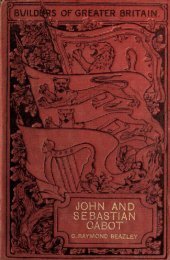st. john of damascus (676-749 - Cristo Raul
st. john of damascus (676-749 - Cristo Raul
st. john of damascus (676-749 - Cristo Raul
You also want an ePaper? Increase the reach of your titles
YUMPU automatically turns print PDFs into web optimized ePapers that Google loves.
"<br />
"<br />
"<br />
"<br />
THE ICONOCLASTIC CONTROVERSY. 53<br />
It had become usual to fall down before images, to<br />
pray to them, to kiss them, to burn lights and incense<br />
in their honour, to adorn them with gems and<br />
precious metals, to lay the hand on them in swearing,<br />
and even to employ them as sponsors at 1<br />
baptism."<br />
The miracles alleged to have been wrought by them<br />
were multiplied. Germanus, Patriarch <strong>of</strong> Con<strong>st</strong>anti<br />
nople, when Leo s fir<strong>st</strong> edict was put forth, dwells<br />
particularly on this as a motive for retaining them ip<br />
veneration. He specifies, in one <strong>of</strong> his letters, an<br />
image 2 <strong>of</strong> the Virgin at Sozopolis in Pisidia, from the<br />
hand <strong>of</strong> which unguents di<strong>st</strong>illed. More famous <strong>st</strong>ill<br />
was the likeness <strong>of</strong> our Lord, said to have been borne<br />
by Ananias to Edessa, and placed by King Abgar in<br />
a niche over the city gate. There it was carefully<br />
concealed by the Bishop <strong>of</strong> Edessa, in the time <strong>of</strong><br />
Abgar s grandson, with a lamp burning before it and<br />
;<br />
when, five centuries after this, the Persians had been<br />
Robertson, ii., p. 91.<br />
1<br />
3 Gieseler, ii., p. 201. It should be observed that, while<br />
the terms "images"<br />
and image- worship are retained, for<br />
want <strong>of</strong> a better sub<strong>st</strong>itute, each <strong>of</strong> them requires some qualifi<br />
cation. The "images" finally sanctioned in the seventh<br />
general council (the second <strong>of</strong> Nicsea, 786), "were not works<br />
<strong>of</strong> sculpture, but paintings and other representations on a flat<br />
surface ;<br />
a limitation to which the Greek Church has ever<br />
since adhered." Robertson, ib., p. 164. We have also, as<br />
Dean Milman has observed, no words corresponding to the<br />
proskunesis and latreia <strong>of</strong> the Greeks ;<br />
the single term wor<br />
ship having to do duty both for the honour implied in the<br />
former, which the Greek divines allowed to be paid to their<br />
icons, and for the service or homage implied in the latter, which<br />
is due to God only. Of course the main que<strong>st</strong>ion is, whether<br />
the multitude practically observed any such di<strong>st</strong>inction.
















